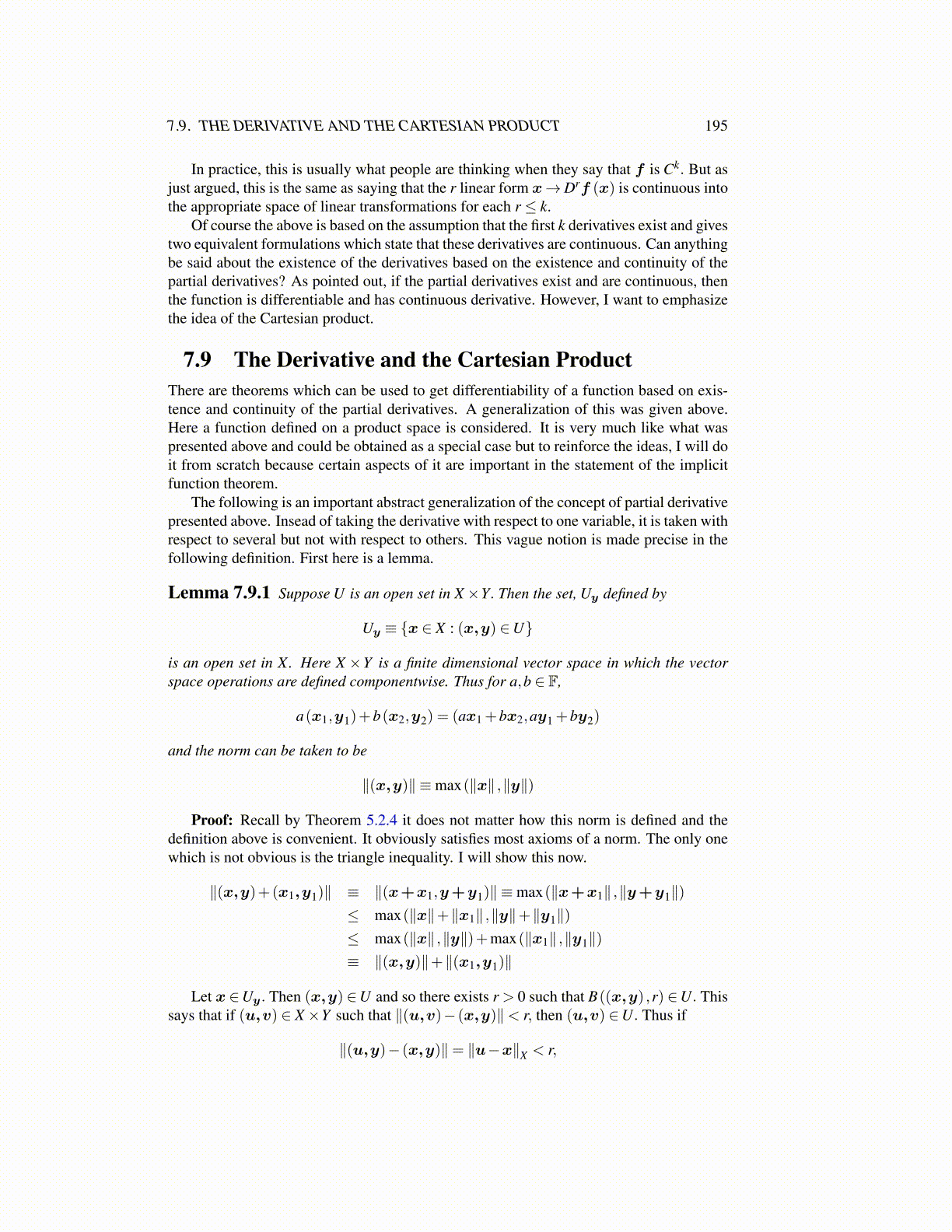
7.9. THE DERIVATIVE AND THE CARTESIAN PRODUCT 195
In practice, this is usually what people are thinking when they say that f is Ck. But asjust argued, this is the same as saying that the r linear form x→Drf (x) is continuous intothe appropriate space of linear transformations for each r ≤ k.
Of course the above is based on the assumption that the first k derivatives exist and givestwo equivalent formulations which state that these derivatives are continuous. Can anythingbe said about the existence of the derivatives based on the existence and continuity of thepartial derivatives? As pointed out, if the partial derivatives exist and are continuous, thenthe function is differentiable and has continuous derivative. However, I want to emphasizethe idea of the Cartesian product.
7.9 The Derivative and the Cartesian ProductThere are theorems which can be used to get differentiability of a function based on exis-tence and continuity of the partial derivatives. A generalization of this was given above.Here a function defined on a product space is considered. It is very much like what waspresented above and could be obtained as a special case but to reinforce the ideas, I will doit from scratch because certain aspects of it are important in the statement of the implicitfunction theorem.
The following is an important abstract generalization of the concept of partial derivativepresented above. Insead of taking the derivative with respect to one variable, it is taken withrespect to several but not with respect to others. This vague notion is made precise in thefollowing definition. First here is a lemma.
Lemma 7.9.1 Suppose U is an open set in X×Y. Then the set, Uy defined by
Uy ≡ {x ∈ X : (x,y) ∈U}
is an open set in X. Here X ×Y is a finite dimensional vector space in which the vectorspace operations are defined componentwise. Thus for a,b ∈ F,
a(x1,y1)+b(x2,y2) = (ax1 +bx2,ay1 +by2)
and the norm can be taken to be
∥(x,y)∥ ≡max(∥x∥ ,∥y∥)
Proof: Recall by Theorem 5.2.4 it does not matter how this norm is defined and thedefinition above is convenient. It obviously satisfies most axioms of a norm. The only onewhich is not obvious is the triangle inequality. I will show this now.
∥(x,y)+(x1,y1)∥ ≡ ∥(x+x1,y+y1)∥ ≡max(∥x+x1∥ ,∥y+y1∥)≤ max(∥x∥+∥x1∥ ,∥y∥+∥y1∥)≤ max(∥x∥ ,∥y∥)+max(∥x1∥ ,∥y1∥)≡ ∥(x,y)∥+∥(x1,y1)∥
Let x ∈Uy. Then (x,y) ∈U and so there exists r > 0 such that B((x,y) ,r) ∈U. Thissays that if (u,v) ∈ X×Y such that ∥(u,v)− (x,y)∥< r, then (u,v) ∈U. Thus if
∥(u,y)− (x,y)∥= ∥u−x∥X < r,